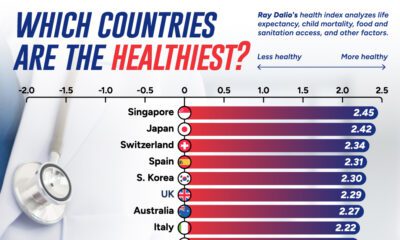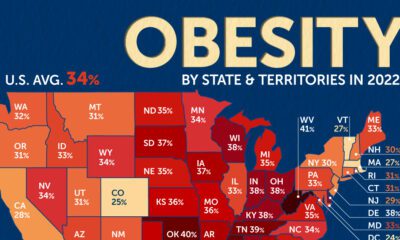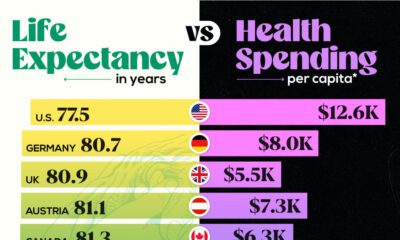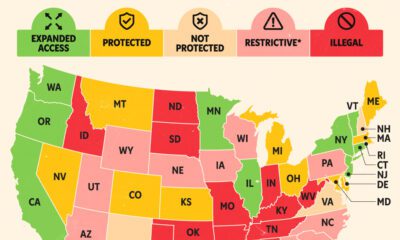
The Severity and Prevalence of Addictive Substances
Addiction is a complex subject, much of our understanding of which is incomplete, as many common and rewarding substances have the potential to be “addictive.” Still, the relative harm associated with that addiction is not linear, nor are the consequences of the addiction.
For this graphic, Visual Capitalist partnered with the Global Kratom Coalition to explore the landscape of addictive substances and investigate why some substances have more risk than others.
How Common Are Substance Use Disorders?
The 2023 United States National Survey on Drug Use and Health (NSDUH) reported that nearly 50 million Americans believed they had some form of substance use disorder (SUD).
SUDs are characterized using 11 criteria, including how dependent a person becomes on a substance and whether the person continues to use it despite adverse effects.
However, a person does not need to meet all 11 criteria to be considered to have an SUD. Instead, the more criteria a person meets, the more severe the SUD is.
It’s worth noting that not everyone reacts to a substance in the same way. People may develop use disorders depending on their genetic predisposition, family history, socioeconomic status, mental disorders, trauma, and, importantly, the substance involved.
| Substance | No Use Disorder | Use Disorder |
|---|---|---|
| Heroin | 14% | 86% |
| Methamphetamine | 32% | 68% |
| Cocaine | 73% | 27% |
| Tobacco | 43% | 57% |
| Kratom | 70% | 30% |
| Caffeine | 92% | 8% |
| Alcohol | 78% | 22% |
| Cannabis | 41% | 59% |
| Ultra-Processed Food | 80% | 20% |
How Severe are Addictive Substances?
A substance can impact a person in various ways. However, the impact is determined by how many of the 11 criteria a person endorses.
So, a person is considered to have ‘mild symptoms’ if they endorse 2-3 criteria, moderate 4-5, and severe would be the endorsement of 6 or more criteria.
When analyzing the symptoms people describe after using certain substances, the severity of these symptoms is heavily dependent on the substance in question. For example, Kratom and caffeine users are more likely to experience mild symptoms, while severe symptoms are more common with substances such as heroin.
| Substance | Mild Symptoms | Moderate Symptoms | Severe Symptoms |
|---|---|---|---|
| Heroin | 20% | 19% | 61% |
| Methamphetamine | 30% | 21% | 49% |
| Cocaine | 39% | 15% | 47% |
| Tobacco | 32% | 39% | 29% |
| Kratom | 47% | 24% | 29% |
| Caffeine | 49% | 29% | 22% |
| Alcohol | 59% | 20% | 21% |
| Cannabis | 55% | 28% | 17% |
| Ultra-Processed Food | 19% | 26% | 55% |
How Many Adverse Events are Caused by Substances?
While substances do impact people in different ways, it’s important to note when this impact becomes an adverse event—a harmful or undesirable outcome resulting from exposure to a toxic substance.
But, the volume of adverse events is also often tied to how many people use the substance in question, with the most common substances like alcohol and cannabis generating the most adverse events—despite their relatively mild symptom profiles.
| Substance | No. of Calls to U.S. Poison Control Centers (2023) |
|---|---|
| Alcohol | 52,883 |
| Cannabis | 28,432 |
| Tobacco | 14,566 |
| Methamphetamine | 7,600 |
| Cocaine | 5,212 |
| Heroin | 4,415 |
| Caffeine | 3,311 |
| Kratom | 1,278 |
Kratom: A Misunderstood Leaf
Millions of people battle against substance abuse every year. However, the severity of symptoms and the impact those symptoms can have on a person vary. But, substance use disorders are common, underscoring the urgent need for a deeper understanding of the complex nature of addiction and substances in general.
Are you interested in continuing the vital conversation around addiction?

Learn More about addiction and the world of Kratom

-

 Healthcare1 week ago
Healthcare1 week agoWhich Countries Are the Healthiest in 2024?
The world’s two healthiest countries are home to ‘blue zones’, where the centenarian population is 10 times higher per capita than America.
-

 Healthcare1 month ago
Healthcare1 month agoRanked: Women’s Life Expectancy in Developed Nations
See the latest data on women’s life expectancy across a group of high-income countries. Can you guess where the U.S. ranks?
-

 Healthcare2 months ago
Healthcare2 months agoMapped: U.S. Obesity Rates, by State
Three U.S. states recorded an adult obesity rate of 40% or higher in 2022. Which states saw the highest obesity rates?
-

 Maps3 months ago
Maps3 months agoMapped: Countries With the Highest Adult Obesity Rates
The U.S. ranks 15th in the highest adult obesity rates. Qatar and Egypt are the only other 1 million+ countries to feature.
-

 Healthcare3 months ago
Healthcare3 months agoCharted: Life Expectancy vs. Health Spending Per Capita
America’s per capita health spend is now past $12,500, but for what gains? A quick comparison with its peers.
-

 Maps3 months ago
Maps3 months agoMapped: Abortion Legality by U.S. State
In June 2022, the U.S. Supreme Court overturned Roe v. Wade, opening the door for states to make their own decisions regarding abortion legality. How did…
The post The Severity and Prevalence of Addictive Substances appeared first on Visual Capitalist.